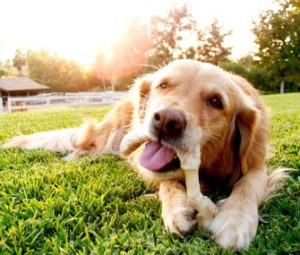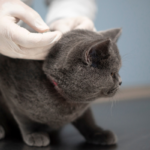Anxiety: a feeling of worry, nervousness or unease about something with an uncertain outcome.
Separation anxiety describes dogs that are overly attached or dependent on family members. During departures or separations they become extremely anxious and show distress behaviors of vocalization, destruction, house-soiling or inactivity when separated from owners. They may follow the owners from room to room and begin to display sign of anxiety as soon as the owners prepare to leave.

Many dogs, especially puppies, enjoy chewing and engage in the behavior when they have nothing better to keep them occupied. Vocalization may be due to territorial intrusion by strangers or other animals. Some dogs will attempt to escape or become extremely anxious when confined, so that destructiveness or house-soiling when a dog is locked up in a crate or laundry, may be due to confinement or barrier anxiety.
The goal of treatment is to reduce your pet’s level of anxiety by training it to feel comfortable in your absence. This can be a long and intensive process. During the initial re-training period it may be best to either: hire a dog sitter, find a friend to care for the dog for the day or board the dog for the day.
Crate training or dog proofing techniques may work especially for those dogs that already have an area where they are used to being confined. Crates should be used with caution however with dogs that have separation anxiety and/or also have barrier frustrations because they can severely injure themselves attempting to get out of a crate.
 Before any lengthy departure, provide a vigorous session of play and exercise. This not only helps reduce some of the dogs energy and tire it out, but also provides a period of attention. For the final 15-30 minutes of departure, the dog should be ignored. Saying goodbye, will only serve to bring attention to departure. A few minutes before you leave, your dog should be given some fresh toys and objects to keep them occupied, so that they may not notice you leave. These include:
Before any lengthy departure, provide a vigorous session of play and exercise. This not only helps reduce some of the dogs energy and tire it out, but also provides a period of attention. For the final 15-30 minutes of departure, the dog should be ignored. Saying goodbye, will only serve to bring attention to departure. A few minutes before you leave, your dog should be given some fresh toys and objects to keep them occupied, so that they may not notice you leave. These include:
– Raw hide or pigs ear
– Kong toy stuffed with treats
– Frozen ice block with treats (great for summer)
Be certain that the distraction devices last as long as possible so that the dog continues to occupy its time until you are ‘long gone’.
Your dog must learn that attention-getting behavior does not pay off. Any attempts at attention must be ignored. On the other hand, lying quietly away from you should be rewarded. Teach your dog that is it the quiet behavior that will receive attention, and not he following you around, or demanding attention. Upon returning home, ignore your dog until it calms and settles down (this may take 10-15 minutes). Over the top greetings or any time of punishment for misbehaving will only heighten the dogs anxiety surrounding homecoming.


Drug therapy can be useful, especially during initial departure training. Often the most suitable drugs for long term use are anti-depressants, anti-anxiety drugs or a combination. Drugs alone will do little or nothing to improve separation anxiety and need to be used in combination with behavior modified techniques.
For more information on training techniques, or if you are concerned about your pets anxiety, call us on 9878 3033 to arrange a behavior consultation with one of our veterinarians.





